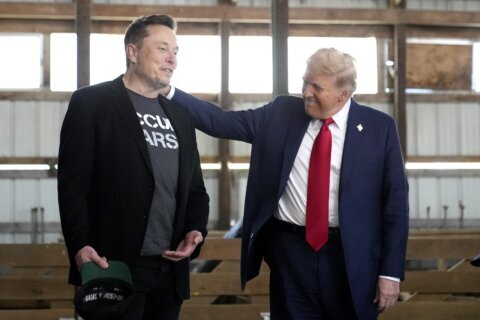During the peak of the dot-com bubble, the top company in the Nasdaq-100 index was Cisco Systems Inc. (ticker: CSCO).
At its height in March 2000, Cisco’s market capitalization exceeded $500 billion, making it the most valuable company in the world at that time. This was driven by massive investments in networking infrastructure and the booming demand for internet technologies.
[Sign up for stock news with our Invested newsletter.]
Cisco’s dominance reflected the speculative fervor of the era, where investors poured money into internet stocks with high expectations of future profits. Despite the eventual burst of the bubble, Cisco remained a significant player in the industry, though its valuation adjusted to more sustainable levels.
While it brought important internet infrastructure to the market, investors holding shares of Cisco had to shoulder heavy losses. From the one-year period from Mar. 27, 2000, to Mar. 27, 2001, Cisco’s market cap had drawn down by around 77%.
Today, the parallels with Nvidia Corp. (NVDA) and the artificial intelligence (AI) boom are striking. Demand for Nvidia’s GPUs has soared, driving record increases in its revenues and numerous earnings beats, along with a 10-for-1 stock split and a dividend hike.
At a $2.8 trillion market cap, Nvidia is currently the third-largest stock in both the S&P 500 and Nasdaq-100, with some analysts confident it will eventually overtake Apple Inc. (AAPL) for the No. 2 spot. However, other analysts are pointing out warning signs.
For instance, Charlie Bilello, chief market strategist at Creative Planning, recently published a chart showing that while Nvidia’s market capitalization exceeded the combined total of all the energy companies in the S&P 500, its net income only clocked in at around a third of the others.
The takeaway? Going all-in on a leading company like Nvidia for AI exposure may not be the most sustainable strategy. Instead, consider diversifying your AI exposure.
This can include other chipmakers like ASML Holdings NV (ASML), social media companies like Meta Platforms Inc. (META), software developers like Microsoft Corp. (MSFT), and even cloud computing providers like Amazon.com Inc. (AMZN).
“We’re in the early stages of the AI cycle, and proper diversification is extremely important — be it across company stages or geographies — because it’s difficult to pick a winner or two this early,” says Tejas Dessai, assistant vice president and research analyst at Global X ETFs. “With a thematic ETF, you’re following an idea as opposed to a complex strategy.”
Here are six of the best AI ETFs to buy now:
| AI ETF | Expense Ratio |
| Invesco AI and Next Gen Software ETF (IGPT) | 0.60% |
| Global X Artificial Intelligence & Technology ETF (AIQ) | 0.68% |
| Global X Robotics & Artificial Intelligence ETF (BOTZ) | 0.68% |
| Roundhill Generative AI & Technology ETF (CHAT) | 0.75% |
| First Trust Nasdaq Artificial Intelligence and Robotics ETF (ROBT) | 0.65% |
| iShares Robotics and Artificial Intelligence Multisector ETF (IRBO) | 0.47% |
Invesco AI and Next Gen Software ETF (IGPT)
“We believe the AI trend will broaden in scope to encompass additional segments of the market, with new technological advancements, a more stable interest rate environment and the ongoing impact of fiscal stimulus broadening innovation across multiple industries,” says Rene Reyna, head of thematic and specialty product strategy at Invesco. For AI exposure, Invesco offers IGPT at a 0.6% expense ratio.
IGPT tracks the STOXX World AC NexGen Software Development Index, which holds large-cap tech companies like Alphabet Inc. (GOOGL), Nvidia and Meta. “The index targets 100 companies from across the globe that generate revenue from various forms of software and artificial intelligence such as data storage, robotics, autonomous vehicles, semiconductors and web platforms,” Reyna says.
Global X Artificial Intelligence & Technology ETF (AIQ)
“AIQ offers a broad and comprehensive exposure to the entire AI value chain, with exposure that ends up looking quite like the Nasdaq-100, but is more tilted toward technology and mid-cap growth,” Dessai says. Unlike the Nasdaq-100, the Indxx Artificial Intelligence & Big Data Index tracked by AIQ does not feature non-tech companies like PepsiCo Inc. (PEP) and Costco Wholesale Corp. (COST).
For a 0.68% expense ratio, investors currently receive exposure to 84 companies with the likes of Nvidia, Qualcomm Inc. (QCOM), Netflix Inc. (NFLX), Meta, Alphabet and Amazon in the top holdings. It is one of the most popular AI-themed ETFs by size, with more than $1.8 billion in assets under management, or AUM, accumulated. AIQ is also fairly tax-efficient with a low 0.16% 30-day SEC yield.
Global X Robotics & Artificial Intelligence ETF (BOTZ)
AIQ isn’t the only AI-focused ETF to be found among Global X’s thematic lineup. The firm also offers BOTZ for an identical 0.68% expense ratio. “We see BOTZ as a more niche play on applied automation,” Dessai says. Compared to AIQ, BOTZ has a lower allocation to software and cloud computing companies, and a higher allocation to industrial and health care companies that are deploying AI and robotics.
While Nvidia is still a top holding at around 11%, the ETF also features stocks like Intuitive Surgical Inc. (ISRG), which makes the famous da Vinci robot designed for minimally invasive surgery. Overall, the ETF’s holdings also tilt further away from U.S. stocks, with a notable 34% tilt toward Japanese industrial companies such as Yaskawa Electric Corp. (OTC: YASKY) that are deploying robotics for manufacturing.
[See: 7 of the Best Ways to Invest $5,000]
Roundhill Generative AI & Technology ETF (CHAT)
“Generative AI is the most exciting technological advancement in years, with the ability to transform how we live and work,” says Dave Mazza, chief executive officer at Roundhill Investments. “We remain in the early stages of adoption and see investors starting to embrace the companies powering this trend.” Examples you may have used include the large language model ChatGPT and image generator DALL-E.
Unlike AIQ or BOTZ, CHAT does not focus on the broad AI ecosystem or applied automation and robotics, respectively. Instead, it largely targets hardware and software companies developing or supporting generative AI development. This actively managed ETF currently has 51 holdings, with Nvidia, Microsoft, Alphabet, Meta and Adobe Inc. (ADBE) in the top spots. It charges a 0.75% expense ratio.
First Trust Nasdaq Artificial Intelligence and Robotics ETF (ROBT)
ROBT’s benchmark, the Nasdaq CTA Artificial Intelligence and Robotics Index, is designed to offer pure-play exposure to AI by classifying potential holdings into three categories: enablers, engagers and enhancers. This is scored based on the nature and degree of a company’s involvement in the AI ecosystem, with engagers being the most involved, and enhancers being the least.
Within each category, the top 30 companies based on their score are selected, and each category is assigned a different weight within the ETF: engagers that design or create AI receiving 60%, enablers that develop building blocks like semiconductors receiving 25%, and enhancers that provide non-core value-added services receiving 15%. ROBT charges a 0.65% expense ratio.
iShares Robotics and Artificial Intelligence Multisector ETF (IRBO)
Thematic ETFs can be expensive. For instance, the 0.68% expense ratio charged by both AIQ and BOTZ works out to around $68 in annual fees for a $10,000 investment. The 0.75% expense ratio charged by the actively managed CHAT would result in around $75 in annual fees for a $10,000 investment. Over time, high fees can compound and eat into long-term returns. For a cheaper alternative, consider IRBO.
This iShares ETF charges a much lower expense ratio of 0.47%, or around $47 in fees annually for a $10,000 investment. It passively tracks the NYSE FactSet Global Robotics and Artificial Intelligence Index, which, unlike the previous ETFs, equal-weights a portfolio of around 100 global AI- and robotics-involved companies. This ensures greater diversification among small- and mid-cap stocks and a less top-heavy portfolio.
More from U.S. News
Do Dave Ramsey’s Stock Market Claims Make Sense?
7 Best Semiconductor ETFs to Buy in 2024
7 of the Best Long-Term Stocks to Buy and Hold
6 of the Best AI ETFs to Buy Now originally appeared on usnews.com
Update 06/03/24: This story was previously published at an earlier date and has been updated with new information.







